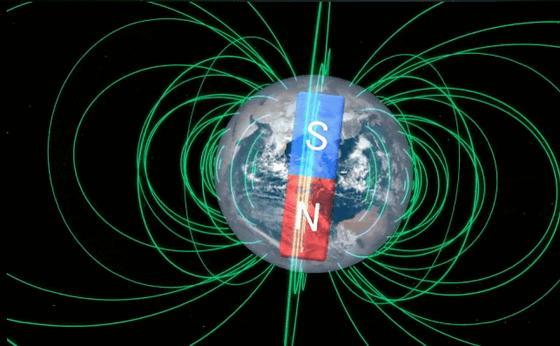Why are the north and south polar aurora different in shape and color?

by Pe_Wu
The aurora, which is observed in the polar region of the earth, is a fantastic astronomical show where bands of green and red light spread to the sky, and has attracted many people since ancient times. Such auroras have similar light emission patterns on the north pole side and the south pole side, but there is a difference in the observed light, so researchers say, "Why are the north and south pole aurora different in shape and color?" I'm investigating about mysteries.
Why Do the Northern and Southern Lights Differ?-Scientific American
https://www.scientificamerican.com/article/why-do-the-northern-and-southern-lights-differ/
The earth has a magnetic field called geomagnetism, with the north pole corresponding to the south pole and the south pole to the north pole. Magnetic lines of force generated in the earth's magnetism exist in an arc that penetrates the atmosphere of the Earth from the south pole side to the north pole side. The area where the earth's magnetic field is acting is called the earth's magnetosphere, which is usually about 10 times the earth's radius from the center of the earth (altitude about 60,000 km).

The solar wind plasma blown from the sun hits the Earth's magnetosphere, and the plasma that can not easily pass through the magnetosphere moves along the magnetic field lines. The plasma accelerates toward the pole where the magnetic lines intersect with the atmosphere, and then collides with the atmosphere of the earth along the magnetic lines. Then, the plasma collides with the atoms and molecules of the atmosphere to generate a fantastic light band ... that is considered to be the principle of the aurora.
This is an image that shows the relationship between the Earth's magnetosphere and the solar wind plasma. The red line is the magnetic field line of the earth, and the plasma falls along the magnetic field line and collides with the atmosphere near the north pole or the south pole. The magnetic lines of the earth have a symmetrical shape if there is no external force, but in reality the magnetic lines are distorted by the strong magnetic field that the sun has, so the solar side (the dayside of the earth) is an elliptical (crusted) In the shape of the sun, the other side of the sun (the night side of the earth) is stretched for a long time.

Auroras are known to occur with similar colors and shapes on the north and south sides, as plasmas dropped along the same magnetic field line collide with the atmosphere simultaneously from north to south. In this way the point of the north-south, which are connected by the same magnetic field lines conjugate point is referred to as, for some reason even in the conjugate point, things and not always entirely can be observed aurora of the same form.
Researchers thought that the magnetic reconnection in the Earth's magnetosphere may be the reason why the north-south aurora do not coincide. In the Earth's magnetosphere, magnetic reconnection means that the fluctuating solar wind shakes the tail of the magnetic field line that hits the night side of the earth, and recombines the stretched magnetic field line closer to the earth than the original connection point. The conventional model is that the auroras with different colors and shapes can be created at asymmetric positions in the north and south by the plasma accumulated in the tail of the magnetosphere being released to the earth side at once by magnetic reconnection.
However, a research team at Bergen University found that the fluctuation model of the aurora due to this magnetic reconnection is incorrect. The research team analyzed the images taken from the spacecraft for aurora simultaneously observed in the northern and southern hemispheres from 2001 to 2005. When this observation was compared with the activity generated in the tail of the Earth's magnetosphere, it turned out that the magnetic reconnection does not change the auroral state from north to south, but rather the symmetry of the aurora increases with the occurrence of magnetic reconnection. That's right.
"Magnetic reconnection in the Earth's magnetosphere has the opposite effect of what people think," said Nikolai Østgaard, a researcher at the Bergen University. Instead, the research team discovered that the sun's magnetic field squeezes the earth's magnetic field unevenly in the north and south, and the distortion of the magnetic field lines in the north and south changes the color, shape, and position of the aurora in the north and south. Did. Magnetic reconnection had the effect of reducing this distortion (asymmetry).

by NASA's Marshall Space Flight Center
Ingo Mueller-Wodarg, a planetary scientist at Imperial College London , described the findings of Østgaard and others as "surprising" in a completely different way from the previous models.
Related Posts:
in Science, Posted by log1h_ik







